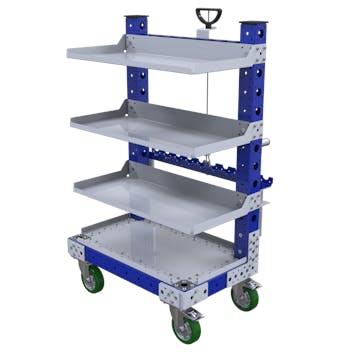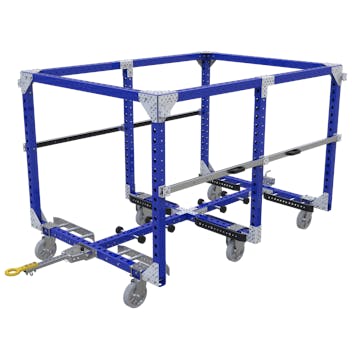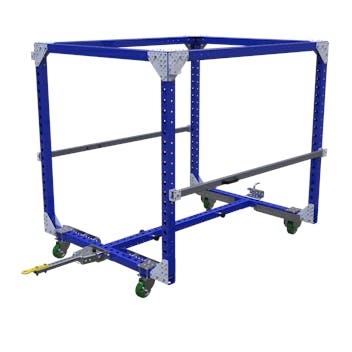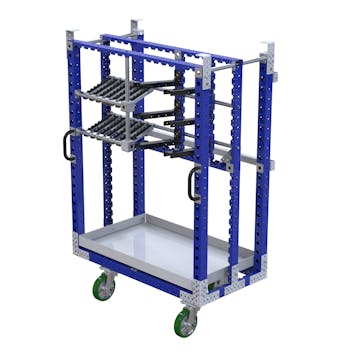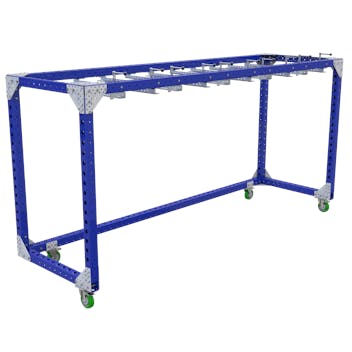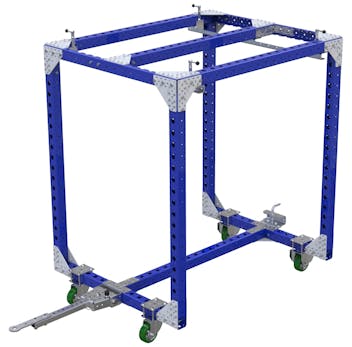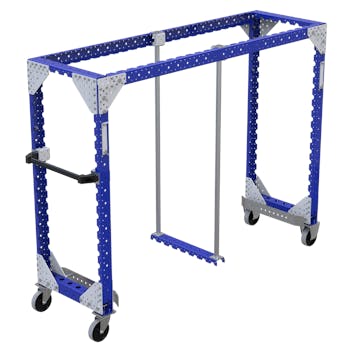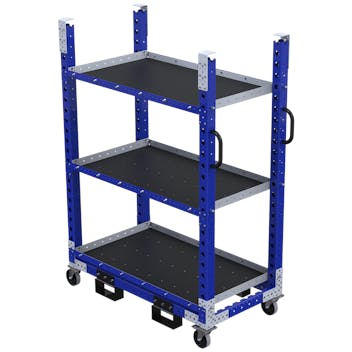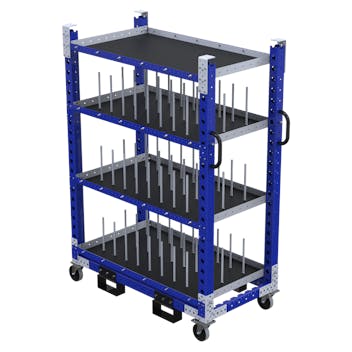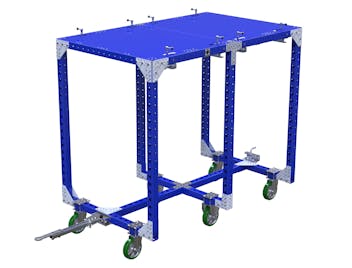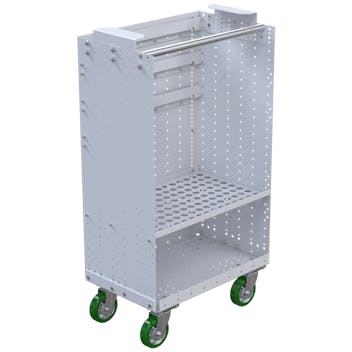Mother-Daughter Carts
A mother-daughter cart concept is a solution by which you can place smaller carts within a larger frame for more efficient use. Easily transport & remove small carts from large carts for optimal placement in the work-station. Our solutions are highly customizable but here are a few of our most popular.
-
![]()
Mother Daughter Cart System 4 in 1 High Dollies with Shelves
Q-100-0089
-
![Mother-Daughter System for Dollies - 1120 x 1470 mm]()
Mother-Daughter System for Dollies – 1120 x 1470 mm
Q-100-1919
-
![Mother cart - 4 in 1 high dollies - 1890 x 910 mm]()
Mother cart – 4 in 1 high dollies – 1890 x 910 mm
Q-100-0851
-
![8 in 1 Mother Daughter System For Dollies - 2240 x 1470 mm]()
8 in 1 Mother Daughter System For Dollies – 2240 x 1470 mm
Q-100-0986
-
![Daughter Cart (700 x 1330 mm) with Flat Shelves]()
Daughter Cart – 700 x 1330 mm
Q-100-0380
-
![Mother-Daughter 4 in 1 - 1190 x 1470 mm]()
Mother-Daughter 4 in 1 – 1190 x 1470 mm
Q-100-1720
-
![]()
Mother Cart – 1470 x 1260 mm
Q-100-7169
-
![]()
Daughter Shelf Cart – 1120 x 420 mm
Q-100-7168
-
![Mother Cart – 2180 x 1540 mm]()
Mother Cart – 2180 x 1540 mm
Q-100-5967
-
![Mother Cart 2 in 1 - 2870 x 1260 mm]()
Mother Cart 2 in 1 – 2870 x 1260 mm
Q-100-5984
-
![Daughter Cart – 840 x 630 mm]()
Daughter Cart – 840 x 630 mm
Q-100-5859
-
![Mother Cart - 2030 x 1050 mm]()
Mother Cart – 2030 x 1050 mm
Q-100-5049
-
![Mother Cart – 1610 x 1120 mm]()
Mother Cart – 1610 x 1120 mm
Q-100-5554
-
![Daughter Cart – 1330 x 980 mm]()
Daughter Cart – 1330 x 980 mm
Q-100-5553
-
![Mother Tugger Cart – 2170 x 1260 mm]()
Mother Tugger Cart – 2170 x 1260 mm
Q-100-5272
-
![Kit Cart – 700 x 490 mm]()
Kit Cart – 700 x 490 mm
Q-100-5287
-
![Mother Tugger Cart – 3150 x 1050 mm]()
Mother Tugger Cart – 3150 x 1050 mm
Q-100-4861
-
![Mother Cart 2 in 1 – 1190 x 2730 mm]()
Mother Cart 2 in 1 – 1190 x 2730 mm
Q-100-4372
-
![Mother Cart – 3010 x 1190 mm]()
Mother Cart – 3010 x 1190 mm
Q-100-5043
-
![Mother Cart – 2660 x 1190 mm]()
Mother Cart – 2660 x 1190 mm
Q-100-4995
-
![Mother Cart – 3080 x 1330 mm]()
Mother Cart – 3080 x 1330 mm
Q-100-4996
-
![Daughter Cart – 1050 x 1050 mm]()
Daughter Cart – 1050 x 1050 mm
Q-100-4371
-
![Mother Cart – 2 in 1 – 700 x 1330 mm]()
Mother Cart – 2 in 1 – 700 x 1330 mm
Q-100-4606
-
![Daughter Cart – 630 x 840 mm]()
Daughter Cart – 630 x 840 mm
Q-100-4739
-
![Mother Tugger Cart – 1610 x 2310 mm]()
Mother Tugger Cart – 1610 x 2310 mm
Q-100-4740
-
![Mother Tugger Cart – 1190 x 1680 mm]()
Mother Tugger Cart – 1190 x 1680 mm
Q-100-4741
-
![Mother Cart – 2 in 1 – 1540 x 2030 mm]()
Mother Cart – 2 in 1 – 1540 x 2030 mm
Q-100-4753
-
![Daughter Cart – 630 x 1540 mm]()
Daughter Cart – 630 x 1540 mm
Q-100-4818
-
![Mother Cart – 1890 x 1540 mm]()
Mother Cart – 1890 x 1540 mm
Q-100-4820
-
![Mother Cart – 980 x 1610 mm]()
Mother Cart – 980 x 1610 mm
Q-100-4293
-
![Kit Cart – 700 x 700 mm]()
Kit Cart – 700 x 700 mm
Q-100-4627
-
![Five-level flat shelf cart designed to transport totes, bins, and boxes.]()
Flat Shelf Cart – 700 x 700 mm
Q-100-4245
-
![Daughter Cart – 700 x 700 mm]()
Daughter Cart – 700 x 700 mm
Q-100-4364
-
![Mother Cart - 1260 x 1610 mm]()
Mother Cart – 1260 x 1610 mm
Q-100-4535
-
![Mother Cart - 4 in 1 - 980 x 1890 mm]()
Mother Cart – 4 in 1 – 980 x 1890 mm
Q-100-3020
-
![Daughter Cart - 840 x 1050 mm]()
Daughter Cart – 840 x 1050 mm
Q-100-3414
-
![Mother Daughter 2 in 1 - 1190 x 2310 mm]()
Mother Daughter 2 in 1 – 1190 x 2310 mm
Q-100-3415
-
![Mother eQart - 2520 x 1470 mm]()
Mother Daughter AGV System – 2 in 1
Q-100-4122
-
![Daughter Cart - 700 x 1330 mm]()
Daughter Cart – 700 x 1330 mm
Q-100-4123
-
![Daughter Cart - 700 x 770 mm]()
Daughter Cart – 700 x 770 mm
Q-100-4191
-
![Mother Cart - 2 in 1 - 840 x 2450 mm]()
Mother Cart – 2 in 1 – 840 x 2450 mm
Q-100-4192
-
![Mother Cart - 2 in 1 - 840 x 1610 mm]()
Mother Cart – 2 in 1 – 840 x 1610 mm
Q-100-4385
-
![Mother cart 6 in 1 – 1960 x 2520 mm]()
Mother cart 6 in 1 – 1960 x 2520 mm
Q-100-2769
-
![Mother Cart 2 in 1 - 770 x 1190 mm]()
Mother Cart 2 in 1 – 770 x 1190 mm
Q-100-3982
-
![]()
Mother AGV 2 in 1 – 2310 x 840 mm
Q-100-3805
-
![]()
AGV – Mother Cart – 1400 x 2170 mm
Q-100-3618
-
![]()
Mother AGV – 1540 x 980 mm
Q-100-3613
-
![Mother Cart - 770 x 1120 mm]()
Mother Cart – 770 x 1120 mm
Q-100-3282
-
![Daughter Cart - 630 x 840 mm]()
Daughter Cart – 630 x 840 mm
Q-100-2768
-
![Mother Cart - 6 in 1 - 1610 x 2380 mm]()
Mother Cart – 6 in 1 – 1610 x 2380 mm
Q-100-1269
-
![Daughter Cart - 645 x 770 mm]()
Daughter Cart – 645 x 770 mm
Q-100-1233
-
![Daughter cart]()
Daughter cart
Q-100-0261
-
![Mother cart]()
Mother cart
Q-100-0260
-
![Daughter Cart - 490 x 1540 mm]()
Daughter Cart – 490 x 1540 mm
Q-100-2280
-
![Mother Cart 6 in 1 - 980 x 2660 mm]()
Mother Cart 6 in 1 – 980 x 2660 mm
Q-100-2618
-
![Daughter Cart - 420 x 630 mm]()
Daughter cart – 420 x 630 mm
Q-100-2617
-
![Mother Cart – 1120 x 1610 mm]()
Mother Cart – 1120 x 1610 mm
Q-100-2130
-
![Mother Cart - 1470 x 1960 mm]()
Mother Cart – 1470 x 1960 mm
Q-100-2332
-
![Mother Cart for Dollies - 770 x 1120 mm]()
Mother Cart For Dollies 2 in 1 – 770 x 1120 mm
Q-100-2644
-
![Mother cart - 4 in 1 high dollies]()
Mother cart – 4 in 1 high dollies
Q-100-2443
-
![2 in 1 - Mother Cart - 1680 x 1890 mm]()
Mother Daughter System – 2 in 1
Q-100-2193
-
![Daughter Cart - 630 x 1470 mm]()
Daughter Cart – 630 x 1470 mm
Q-100-2192
-
![Mother Cart - 1050 x 1540 mm]()
Mother Cart – 1050 x 1540 mm
Q-100-2552
-
![Mother Cart - 3 in 1 - 840 x 2380 mm]()
Mother Cart – 3 in 1 – 840 x 2380 mm
Q-100-2272
-
![Mother Cart - 2030 x 1260 mm]()
Mother Cart – 2030 x 1260 mm
Q-100-2565
-
![Kit Daugther Cart - 700 x 1330 mm]()
Kit Daugther Cart – 700 x 1330 mm
Q-100-2351
-
![Shelf Kit Cart - 700 x 1330 mm]()
Shelf Kit Cart – 700 x 1330 mm
Q-100-2273
-
![Mother Cart 4 in 1 - 1400 x 3430 mm]()
Mother Cart 4 in 1 – 1400 x 3430 mm
Q-100-2662
-
![Daughter Cart - 560 x 1400 mm]()
Daughter Cart – 560 x 1400 mm
Q-100-2661
-
![Daughter Cart - 420 x 770 mm]()
Daughter Cart – 420 x 770 mm
Q-100-2228
-
![Mother cart - 980 x 3220 mm]()
Mother cart – 980 x 3220 mm
Q-100-2227
-
![Mother cart 2 in 1 - 1190 x 1470 mm]()
Mother cart 2 in 1 – 1190 x 1470 mm
Q-100-1472
-
![Mother Cart 2 in 1 - 2310 x 980 mm]()
Mother Cart 2 in 1 – 2310 x 980 mm
Q-100-1270
-
![Mother cart 4 in 1 - 2310 x 560 mm]()
Mother cart 4 in 1 – 2310 x 560 mm
Q-100-0960
-
![Daughter Cart - 420 x 700 mm]()
Daughter Cart – 420 x 700 mm
Q-100-2052
-
![Mother Cart - 560 x 1820 mm]()
Mother Cart – 560 x 1820 mm
Q-100-2053
-
![Mother Cart - 770 x 1715 mm]()
Mother Cart – 770 x 1715 mm
Q-100-2038
-
![Mother Cart 2 in 1 - 770 x 1190 mm]()
Mother Cart 2 in 1 – 770 x 1190 mm
Q-100-2007
-
![Daughter Pallet Cart - 420 x 630 mm]()
Daughter Pallet Cart – 420 x 630 mm
Q-100-2006
-
![Daughter Cart - 1260 x 1260 mm]()
Daughter Cart – 1260 x 1260 mm
Q-100-1962
-
![Daughter Cart - 980 x 1260 mm]()
Daughter Cart – 980 x 1260 mm
Q-100-1960
-
![Mother Cart 4 in 1 - 1540 x 3570 mm]()
Mother Cart 4 in 1 – 1540 x 3570 mm
Q-100-1944
-
![Daughter Shelf Cart - 700 x 1330 mm]()
Daughter Shelf Cart – 700 x 1330 mm
Q-100-1942
-
![Daughter Shelf Cart w. Dividers - 700 x 1330 mm]()
Daughter Shelf Cart w. Dividers – 700 x 1330 mm
Q-100-1943
-
![Mother Cart for Dollies - 770 x 1120 mm]()
Mother Cart for Dollies – 770 x 1120 mm
Q-100-1921
-
![Mother Cart 4 in 1 - 1190 x 2380 mm]()
Mother Cart 4 in 1 – 1190 x 2380 mm
Q-100-1917
-
![Mother Cart 2 in 1 - 1190 x 1260 mm]()
Mother Cart 2 in 1 – 1190 x 1260 mm
Q-100-1872
-
![Daughter Cart - 420 x 980 mm]()
Daughter Cart – 420 x 980 mm
Q-100-1871
-
![Daughter Cart - 490 x 700 mm]()
Daughter Cart – 490 x 700 mm
Q-100-1515
-
![Mother-Daughter System for Dollies - 1120 x 770 mm]()
Mother-Daughter System for Dollies – 1120 x 770 mm
Q-100-1118
-
![Daughter Cart - 910 x 1540 mm]()
Daughter Cart – 910 x 1540 mm
Q-100-1535
-
![Cart for totes - 420 x 630 mm]()
Cart for totes – 420 x 630 mm
Q-100-1420
-
![Daughter Cart - 560 x 1540 mm]()
Daughter Cart – 560 x 1540 mm
Q-100-1335
-
![Mother Cart - 2 in 1 - 1820 x 1260 mm]()
Mother Cart – 2 in 1 – 1820 x 1260 mm
Q-100-1336
-
![Mother Cart 2 in 1 - 1610 x 1680 mm]()
Mother Cart 2 in 1 – 1610 x 1680 mm
Q-100-1333
-
![Mother Cart - 4 in 1 - 1610 x 840 mm]()
Mother Cart – 4 in 1 – 1610 x 840 mm
Q-100-1337
-
![Mother Cart - 2030 x 1260 mm]()
Mother Cart – 2030 x 1260 mm
Q-100-1002
-
![Mother cart 2 in 1 - 1680 x 1610 mm]()
Mother cart 2 in 1 – 1680 x 1610 mm
Q-100-1043
-
![Kit Cart – 630 x 420 mm]()
Kit Cart – 630 x 420 mm
Q-100-0835
-
![Daughter cart w. 4 shelves]()
Daughter cart w. 4 shelves
Q-100-0978
What is a Mother-Daughter Cart?
A mother-daughter cart concept is a solution by which you can place smaller carts within a larger frame for more efficient use. A mother cart is a cart or frame that holds daughter carts within it, therefore creating a mother-daughter cart solution. The benefit of this is that operators can leave the daughter carts at different work stations and assembly areas. Also, it means that not all carts need to be equipped with a tow bar.
Why Buy a FlexQube Mother-Daughter Cart?
The Mother-daughter cart concept with the FlexQube system (or Routenzug in German) is the most versatile and flexible solution on the market. The carts and trolleys can be integrated with many of the different mother-daughter systems on the market including the STILL Liftrunner E-frame, B-frame or C-frame system and the Linde Tugger Train with, e.g., the Bridge Type design. FlexQube also offers other types of mother-daughter system, including frames for small carts. That can include 1, 2, 3, 4 or 6 daughter carts in the same mother frame. These solutions make it possible to disconnect the daughter cart from the mother cart and place at work stations or the assembly line quickly and ergonomically. The daughter carts are also easily pushed onto the mother carts and locked into position.
The carts are lighter than welded carts and lock safely and quickly into the mother cart frame.
While other companies provide standard sized mother frames and solutions, FlexQube can offer custom made designs using the LEGO® inspired building block system.
Since the beginning of FlexQube, we have spent much time and effort not only into setting up the most versatile cart system but also into designing state of the art and modern material handling solutions including durable, efficient and ergonomically desired mother/daughter cart system.
Our daughter carts and trolleys are either transported on the floor with no need to push them up a ramp which is cumbersome and sometimes impossible to do for some operators. The unloading of daughter carts from other mother-daughter cart systems on the market, where the carts are rolled onto an angled ramp is very dangerous. If the operator would trip or fall and get a 2000 lbs (approx. 910 kg) container cart coming at his or her legs. This is not the case with the FlexQube mother-daughter cart systems. We also integrate our carts with the STILL Liftrunner system where the carts are raised off the floor using hydraulic or pneumatic.
Choosing between a tongue and hitch tugger train system and a mother-daughter type can be tricky. Below we try to bring up some pros and cons with both concepts. FlexQube can supply carts and dollies that would work with both a tongue and hitch setup, as well with different mother-daughter cart concepts.
If you connect the carts together with a tow bar, it is possible to create what we at FlexQube refer to as a ‘low rider’ (sometimes referred to as a lowboy cart). This is a cart that has a very low loading height (a short distance from the floor to the loading deck). That makes it possible to stack taller loads and bring more material at the same time, which improves productivity. This can be done while also having the material presented in an ergonomic height for the operators. With great quality and proven heavy duty 5 inch (125 mm) polyurethane casters that are integrated into the cart base, the steel deck will sit just about 5.5 inch (135 mm) off the ground. With the high-quality casters, the carts run silently around the plant and work perfectly on many floors, even floors in poor condition.
Since no frame limits the size of the dollies, as in a tugger system based on separate frames, the possibility to mix and match carts in different sizes in the train is unlimited. That allows great flexibility to bring different sized containers and types of carts; kit-carts, pallet carts or shelf carts, in the same train set, mixed differently on each route.
By being independent of the frames, the number of carts in each tugger train is also adjustable/flexible. Run 1,2,3,4,5,6,7,8 carts (or more depending on your forklift aisle width) in the same train and connect and disconnect as you wish since there are no frames setting the limit for the number of carts at the same time. Just as well, there will be no empty slots in the train if you only need to run two carts but have four frames, where two will be empty if you use the mother-daughter type concept.
Most of the mother-daughter frame systems today only allow release on one side of the frame. One exception to this is the B-frame sold by STILL GmbH that FlexQube has an official partnership with. This means that the routes must be planned in such a way that the frames are set to open to the side where the material is needed. Since there is a need for a handlebar, most of the times to allow ergonomic handling of the dollies for the operator, the dollies need to be rotated 180 degrees when taken off the train and placed at the work station. That kind of movement is one of the worst from an ergonomic standpoint for the human body and something that HSE (Health, Safety, and Environment) officers often complain about.
Using a tongue and hitch system with fixed casters placed in the center of the cart allows release from the train to both sides of the aisle. It is also much easier to turn the cart to its intended position at the line since it is only needed to turn 90 degrees. And anyone who has tried to move a cart with four swivel casters compared to a cart with fixed casters in the center of the cart and swivel in the short ends, knows how much easier this is.
Release cart and turn to either side of the aisle with fixed casters in center of the cart.
Fixed casters in the center of the cart and tongue and hitch setup allows the release to both sides of the aisle.
A natural benefit that is always included in the FlexQube concept is more lightweight carts compared to welded carts. As a matter of fact, in a direct comparison between FlexQube and competing cart suppliers on the US market, one of our customers found the FlexQube cart to be 40% lighter. This cart holds 2000 lbs. (approx. 910 kg) and the customer has been using 100 of these carts for three years now.
Another important aspect concerning the release of the carts is the angled ramp or slope that some tugger train suppliers use. The ramp has a slight incline allowing the daughter cart to be connected to the mother cart without having the casters of the daughter cart touching the ground during transport. This means that heavy carts must be pushed up a ramp, against gravity, something that can be difficult for operators to handle. The greater risk though lies in the fact that upon the release of the daughter cart from the mother frame, the daughter carts slides off the ramp in a motion that could cause injuries if the operator trips and have the cart hitting him or her. This specific risk has also been identified by some of our clients, causing them to prohibit this kind of push up mother daughter cart system in their plants, just from a safety perspective.
Heraclitus, who lived about 500 BC, already then realized one important thing that is the core of the FlexQube concept; ‘Change is the only constant.’ Even 2500 years back, Heraclitus got it right; nothing will stay the same forever, it all changes. And nowadays that is truer than ever.
Volumes change, mix change, product change. More and more often.
FlexQube believes that making welded carts in this market environment is a bad idea. Using a fixed mother cart frame system in an environment where the mix is high and products and things change rapidly could be a bad idea as well. But keeping a standard frameset could also be something that limits the variation and sets the boundaries for the logistics system. But, in that case, make sure to have the flexibility built into your carts instead.
With the FlexQube concept, the daughter carts can be adapted to new brands of mother frames, new sizes, and so on. The way of moving the carts can also be changed over time. It could just as well start out as carts to be used in a mother-daughter tugger system but later change to an AGV or Robot integration. With the modularity in the FlexQube concept, this is possible to a whole other extent compared to welded solutions.















